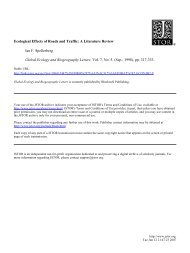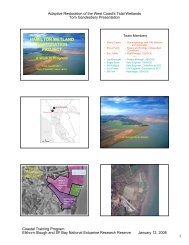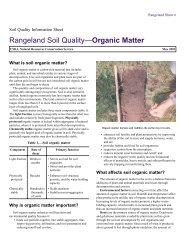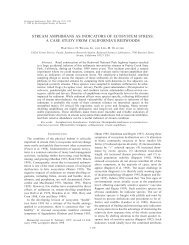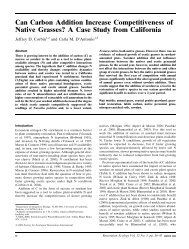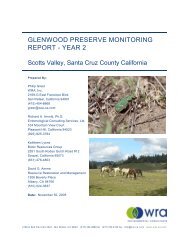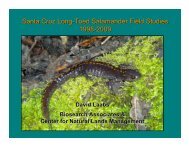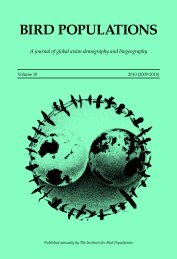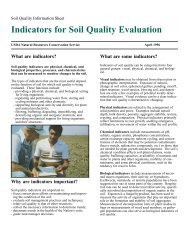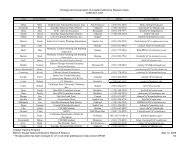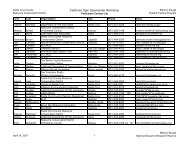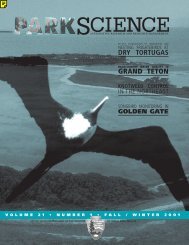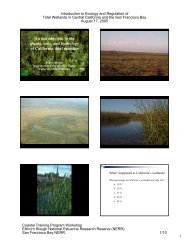Recreation and large mammal activity in an urban nature reserve
Recreation and large mammal activity in an urban nature reserve
Recreation and large mammal activity in an urban nature reserve
Create successful ePaper yourself
Turn your PDF publications into a flip-book with our unique Google optimized e-Paper software.
108 BIOLOGICAL CONSERVATION 133 (2006) 107– 117rodents (Ma<strong>in</strong><strong>in</strong>i et al., 1993; Magle et al., 2005), birds (Yalden<strong><strong>an</strong>d</strong> Yalden, 1990; Miller et al., 1998; Stalmaster <strong><strong>an</strong>d</strong> Kaiser,1998; Fernández-Juricic et al., 2005), herpetiles (Hecnar <strong><strong>an</strong>d</strong>M’Closkey, 1998; Lacy <strong><strong>an</strong>d</strong> Mart<strong>in</strong>s, 2003; Rodríquez-Prieto<strong><strong>an</strong>d</strong> Fernández-Juricic, 2005), <strong><strong>an</strong>d</strong> coral (Zakai <strong><strong>an</strong>d</strong> Chadwick-Furm<strong>an</strong>,2002).Mammali<strong>an</strong> carnivores, given their low population densities,<strong>large</strong> area requirements, <strong><strong>an</strong>d</strong> historical <strong><strong>an</strong>d</strong> current persecution,may be especially sensitive to <strong>an</strong>thropogenicdisturb<strong>an</strong>ces (Terborgh, 1974; Pimm et al., 1988; Breitenmoser,1998; Woodroffe <strong><strong>an</strong>d</strong> G<strong>in</strong>sberg, 1998; Woodroffe, 2000; Crooks,2002; Gittlem<strong>an</strong> et al., 2001; Ray et al., 2005), <strong><strong>an</strong>d</strong> prior studieshave suggested hum<strong>an</strong> recreation c<strong>an</strong> alter carnivore behavior<strong><strong>an</strong>d</strong> distribution (e.g. Aaris-Sorensen, 1987; Olson et al.,1997; White et al., 1999; Nev<strong>in</strong> <strong><strong>an</strong>d</strong> Gilbert, 2005a,b). Likewise,hum<strong>an</strong> recreation c<strong>an</strong> also disturb ungulates, <strong>in</strong>itiat<strong>in</strong>g alert<strong><strong>an</strong>d</strong> flush responses <strong><strong>an</strong>d</strong> potentially result<strong>in</strong>g <strong>in</strong> decreasedforag<strong>in</strong>g or reproduction, <strong>in</strong>creased energetic costs or stress,<strong><strong>an</strong>d</strong> avoid<strong>an</strong>ce of recreational areas (Eckste<strong>in</strong> et al., 1979;MacArthur et al., 1982; Freddy et al., 1986; Yarmoloy et al.,1988; Papouchis et al., 2001; Miller et al., 2001; Taylor <strong><strong>an</strong>d</strong>Knight, 2003). Although most studies of recreational impactson <strong>large</strong> <strong>mammal</strong> <strong>activity</strong> have occurred <strong>in</strong> relatively naturalsett<strong>in</strong>gs, wildlife <strong>in</strong> urb<strong>an</strong> systems may be exposed to particularlyhigh levels of hum<strong>an</strong> recreation. The consequences of<strong>in</strong>creased exposure to recreation, however, rema<strong>in</strong> unclear,<strong>in</strong> that wildlife may become desensitized to recurrent hum<strong><strong>an</strong>d</strong>isturb<strong>an</strong>ces <strong>in</strong> some situations but not others, <strong><strong>an</strong>d</strong> suchhabituation may have both beneficial <strong><strong>an</strong>d</strong> negative impacts(Knight <strong><strong>an</strong>d</strong> Gutzwiller, 1995; Whittaker <strong><strong>an</strong>d</strong> Knight, 1998;Taylor <strong><strong>an</strong>d</strong> Knight, 2003; Kloppers et al., 2005; Magle et al.,2005; Smith et al., 2005).Highly urb<strong>an</strong> regions are often characterized by rapidexp<strong>an</strong>sion, which leads to habitat loss <strong><strong>an</strong>d</strong> fragmentation,the primary threat to end<strong>an</strong>gered species <strong>in</strong> the UnitedStates (Wilcove et al., 1998). Widespread urb<strong>an</strong>ization, <strong>in</strong>comb<strong>in</strong>ation with high levels of species endemism <strong><strong>an</strong>d</strong>diversity, has created a major ‘hot-spot’ of ext<strong>in</strong>ction <strong>in</strong>coastal southern Californi<strong>an</strong> natural communities (Myers,1990; Dobson et al., 1997). Or<strong>an</strong>ge County, California, is onesuch coastal region to experience massive hum<strong>an</strong> populationgrowth. Between 1950 <strong><strong>an</strong>d</strong> 1990, Or<strong>an</strong>ge County’s population<strong>in</strong>creased 10-fold, from approximately 200,000 to over2,400,000 (State of California, 2001), with a projected populationof nearly 3.2 million <strong>in</strong> 2010 (State of California, 2004).In response to urb<strong>an</strong> sprawl <strong><strong>an</strong>d</strong> result<strong>an</strong>t habitat fragmentation,The Nature Reserve of Or<strong>an</strong>ge County (NROC) wascreated to p<strong>reserve</strong> some of the region’s last rema<strong>in</strong><strong>in</strong>g naturalareas. Although the NROC protects over 150 km 2 of openspace, hous<strong>in</strong>g <strong><strong>an</strong>d</strong> commercial units encircle <strong><strong>an</strong>d</strong> fragmentthe <strong>reserve</strong>, <strong><strong>an</strong>d</strong> development is cont<strong>in</strong>u<strong>in</strong>g. The NROC ispermeated by foot <strong><strong>an</strong>d</strong> bike trails, ma<strong>in</strong>ta<strong>in</strong>ed dirt roads,<strong><strong>an</strong>d</strong> dry creek beds, which c<strong>an</strong> serve, <strong>in</strong> vary<strong>in</strong>g degrees, asmovement routes for local wildlife as well as hum<strong>an</strong> recreationists,such as hikers, bicyclists, horseback riders, <strong><strong>an</strong>d</strong> dogwalkers.The goal of this study was to <strong>in</strong>vestigate the relationshipbetween <strong>large</strong> <strong>mammal</strong> <strong>activity</strong> patterns <strong><strong>an</strong>d</strong> hum<strong>an</strong> recreation<strong>in</strong> <strong>an</strong> urb<strong>an</strong> <strong>nature</strong> <strong>reserve</strong>. We assessed the spatial<strong><strong>an</strong>d</strong> temporal <strong>activity</strong> patterns of bobcat (Lynx rufus), coyote(C<strong>an</strong>is latr<strong>an</strong>s), <strong><strong>an</strong>d</strong> mule deer (Odocoileus hemionus), as wellas hum<strong>an</strong>s <strong><strong>an</strong>d</strong> domestic dogs, us<strong>in</strong>g <strong>in</strong>fra-red remotely triggeredcameras, valuable survey tools because they c<strong>an</strong> recorddaily <strong>activity</strong> patterns for <strong>an</strong> extended period of time withm<strong>in</strong>imal supervision (Carthew <strong><strong>an</strong>d</strong> Slater, 1991; Cutler <strong><strong>an</strong>d</strong>Sw<strong>an</strong>n, 1999; Carbone et al., 2001). We hypothesized that <strong>in</strong>areas of higher hum<strong>an</strong> recreation, <strong>large</strong> <strong>mammal</strong>s would exhibitlower trail use, particularly dur<strong>in</strong>g the daytime when hum<strong>an</strong>recreationists are most active.2. Methods2.1. Study areaThe NROC is a <strong>reserve</strong> system sp<strong>an</strong>n<strong>in</strong>g the central portion ofOr<strong>an</strong>ge County, California. Hum<strong>an</strong> recreation <strong>in</strong> the <strong>reserve</strong>varies due to differ<strong>in</strong>g restrictions. M<strong>an</strong>y parcels allow recreationon a daily basis <strong><strong>an</strong>d</strong> often year-round. Hum<strong>an</strong> recreation<strong>activity</strong> is consistently high <strong>in</strong> these areas, boththroughout the daytime hours <strong><strong>an</strong>d</strong> throughout the year. Otherparcels are limited to docent-led tours (e.g. l<strong><strong>an</strong>d</strong>s m<strong>an</strong>aged byThe Nature Conserv<strong>an</strong>cy) or completely closed to the generalpublic. These areas typically receive relatively low levels ofhum<strong>an</strong> <strong>activity</strong> throughout the year, although trespass<strong>in</strong>gdoes occur. Much of the NROC, <strong>in</strong>clud<strong>in</strong>g areas with both high<strong><strong>an</strong>d</strong> low levels of hum<strong>an</strong> recreation, supports native habitat<strong><strong>an</strong>d</strong> wildlife communities.The <strong>reserve</strong> is divided <strong>in</strong>to two core areas: the coastal subregion(ca. 73 km 2 ) <strong><strong>an</strong>d</strong> the central sub-region (ca. 77 km 2 ).The coastal sub-region is bordered by the Pacific Oce<strong>an</strong> tothe southwest <strong><strong>an</strong>d</strong> by cities <strong>in</strong> all other directions. The centralsub-region is located at the northwestern term<strong>in</strong>al portion ofthe S<strong>an</strong>ta Ana Mounta<strong>in</strong> r<strong>an</strong>ge. It is connected to the Clevel<strong><strong>an</strong>d</strong>National Forest to the east <strong><strong>an</strong>d</strong> bordered by cities <strong>in</strong> allother directions. The city of Irv<strong>in</strong>e <strong><strong>an</strong>d</strong> major freeway systemsseparate the two sub-regions <strong><strong>an</strong>d</strong>, at present, there are few tono viable habitat corridors for <strong>large</strong> <strong>mammal</strong>s connect<strong>in</strong>g thetwo portions of the <strong>reserve</strong>.Coastal southern California has a Mediterr<strong>an</strong>e<strong>an</strong> type climatewith <strong>an</strong> average <strong>an</strong>nual precipitation level of less th<strong>an</strong>38 cm per year <strong><strong>an</strong>d</strong> two seasons: dry (June–November) <strong><strong>an</strong>d</strong>wet (December–May). The majority of our <strong>large</strong> <strong>mammal</strong> surveys(86% of sampl<strong>in</strong>g effort) occurred <strong>in</strong> the dry season,although some sampl<strong>in</strong>g at some sites cont<strong>in</strong>ued <strong>in</strong>to theearly wet season. Coastal sage scrub, chaparral, <strong><strong>an</strong>d</strong> oakwoodl<strong><strong>an</strong>d</strong>s are the dom<strong>in</strong><strong>an</strong>t habitat types with<strong>in</strong> the NROC,although open grassl<strong><strong>an</strong>d</strong>s <strong><strong>an</strong>d</strong> ripari<strong>an</strong> habitat also exist. Percentcover of native <strong><strong>an</strong>d</strong> exotic pl<strong>an</strong>t species was estimatedwith<strong>in</strong> a 20-m radius of each sampl<strong>in</strong>g station by follow<strong>in</strong>ga modified Braun-Bl<strong>an</strong>quet categorical scale (Kent <strong><strong>an</strong>d</strong> Coker,1992). The cover scale was 0 (absent), 1 (



